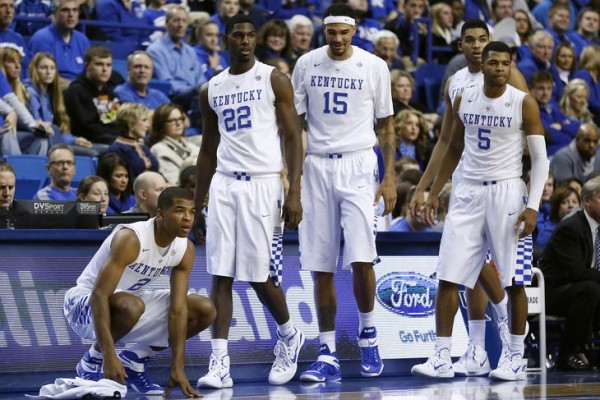Is Kentucky’s Platoon System Built to Last?
Posted by Bennet Hayes on November 19th, 2014John Calipari has been known to indulge in a bit of hyperbole from time to time, which forced most of us to take the preseason news of his installment of a hockey-style, 5-for-5 substitution system at Kentucky with a grain of salt. Super cool that you have a roster deep enough to float an idea like this, Coach Cal, but lets talk when actual games begin, okay? Impediments to wholesale substitution patterns go well beyond having a short roster. Foul trouble, injuries and varying match-ups are all reasons to maintain the classic flexibility of free substitutions. Even with a Kentucky roster overflowing with ability, this mindless platoon system Calipari was espousing seemed suboptimal at best and viciously exploitable at worst.
Or so the thinking went. After Kentucky walloped Kansas by 32 points in Tuesday night’s Champions Classic, it is suddenly evident that Calipari’s decision to eschew convention has the potential to pay massive dividends. At least for a night, there were no complaints about playing time. Rhythm remained steady as the units exchanged places, and both blue and white platoons played with the sort of boundless energy that Calipari dreamed this arrangement could foster. You could pull any five guys out of the Kentucky 10-deep and field a sufficiently scary basketball team, but the relentlessness of a long, athletic Wildcats front line was significantly magnified by the five-in, five-out waves that Kansas had to fight through all night. The Wildcats not only looked like the best team in the country on Tuesday night, but also a potentially unbeatable best team in the country.
Calipari praised Andrew Harrison and Tyler Ulis after the game for the job they did running the team (deservedly, as Kentucky only turned the ball over six times), but the story of this game was undoubtedly the Kentucky frontcourt. The Wildcats’ roster features 10 players taller than 6’6”, seven taller than 6’8” and four taller than 6’10”. All that height was put to good use on Tuesday. The Cats blocked 11 shots (four apiece for blue-platooner Karl-Anthony Towns and white-platooner Marcus Lee), outrebounded Kansas by five, and harassed the Jayhawks into sub-20% field-goal shooting (11-of-56). Long-armed, fresh Kentucky defenders were everywhere; easy baskets for Kansas became non-starters on this night. Bill Self’s team had to grind for every bucket, and the cumulative effect of the harassment was felt during a game-breaking 26-8 Wildcat run to open the second half. Broken wills aren’t found often in seasons this young, but Kansas looked spooked Tuesday night. Games like this just don’t happen to Bill Self-coached teams.
Kentucky was voted the preseason No. 1 team long before the platoon system was unveiled, and Calipari had the most talented roster in America before he began calling substitutions “reinforcements.” So why are we chalking Tuesday’s victory up to Cal’s innovation? Why is there any reason to believe the platoon system will survive December, much less the entire season? The simple answer: Calipari. All 10 of these guys must continue to sip the platoon Kool-Aid if the system is to keep building momentum, and no college basketball coach serves the Kool-Aid better than Cal. At least for the time being, he has made mass-substituting fun in Lexington. After watching the demolition of the Jayhawks last night, it’s now possible to conceive of a world in which each platoon of five relishes in the success of the other, all the while readying themselves for their next burst of basketball. Again, making this egoless approach persist for an entire season is vastly different than bearing witness to it for a night, but Calipari has a personality prodigious enough to take on the task.
In the ’80s and early ’90s, the term “Hoya Paranoia” entered the college basketball lexicon. Catchy rhyme, yes, but John Thompson and Georgetown had earned the name, too. The Hoyas’ shot-blockers were empowered to do anything they wanted to intimidate opposing field-goal attempters. Finger-wagging was allowed. Goaltending (within reason) was tacitly encouraged. The result of their efforts was a menacing aura that rewarded Thompson’s team on the court in ways that went untracked by a stat sheet. If the Kentucky platoon project is to succeed, a similarly intangible psychological impact must be cultivated. Calipari is almost surely sacrificing some measure of efficiency by choosing this route (limiting the Harrison twins minutes would appear to be the most blatant example), so he must find a payoff in consistently high energy and aggression levels – to the point where opponents fear the waves of five before they’ve even started coming.
Calipari was Calipari after the game (of course), but amid his predictable bluster, he offered a simple truth. “They will dictate what we do,” he said, when asked how long the platoon system will last. He may be the only coach in college basketball crazy enough to try it, but he’s right: His players will decide when it will end. If Tuesday night is any indication, this Kentucky 10 may choose to keep their reinforcements coming for quite a while, perhaps all the way back to Indianapolis, just five blocks down the street.














































The answer to your Q is a resounding “YES” in my opinion. This is a ridiculously genius idea that could only be executed with a roster like this… the personnel is there, and it’s going to work. Magically. In my opinion